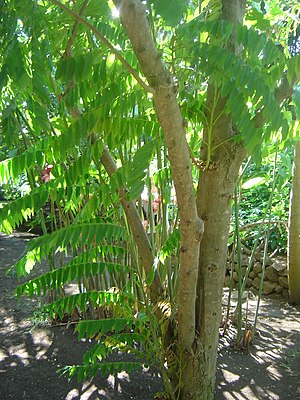Cucumber tree
| Cucumber tree | ||||||||||||
|---|---|---|---|---|---|---|---|---|---|---|---|---|

Cucumber tree ( Averrhoa bilimbi ) |
||||||||||||
| Systematics | ||||||||||||
|
||||||||||||
| Scientific name | ||||||||||||
| Averrhoa bilimbi | ||||||||||||
| L. |
The cucumber tree ( Averrhoa bilimbi ), also called bilimbi , is one of two species from the genus of the cucumber trees ( Averrhoa ) next to the star fruit . They belong to the wood sorrel family (Oxalidaceae) and come from Southeast Asia , but are cultivated worldwide in the tropics and subtropics.
description
Vegetative characteristics

The evergreen cucumber tree can reach heights of up to 15 meters, but usually remains a bit smaller. The trunk diameter reaches up to 30 centimeters. Twigs and branches grow upwards. The leafy branches have a thickness of about 7 mm and are hairy with a dense, brownish or yellowish fuzz . The relatively smooth bark is brown.
The alternate, compound and imparipinnate leaves are up to 60–65 cm long and are arranged at the branch ends. The petioles are 4 to 13 (17) cm long, about 2.5 mm thick and densely downy and widened at the base. 13 to 39, ganzrandige and short-stemmed, often hanging pinna per sheet flake present, the leaf blade of the leaflets is 2.5 cm to 8 (15) cm long and 1.2 to 3 (5). They are ovate to lanceolate or oblong and partly asymmetrical, pointed to pointed at the tip and rounded to blunt at the base. Both the top and bottom are hairy with fine fluffy hair. The stipules are missing.
Inflorescences and flowers
Consisting cymes , traubig , paniculate composite inflorescences are in the leaf axils or kauliflor (stammblütig) on the trunk and (ramiflor) on the branches. They consist of 15 to 20 flowers and are finely felted and hairy with glands. The bracts are 4 mm long, the awl-shaped bracts have a length of 1.5 to 2 mm. The glandular-haired flower stalks are 4 to 20 mm long and clearly divided near the middle (joint).
The small, fragrant flowers are hermaphroditic, radial symmetry and five-fold. The five, slightly hairy on the outside, greenish to reddish sepals are fused at their base, 1.5 to 2.5 mm long, 1.5 to 3 mm wide and egg-shaped to elliptical, only one inner sepal is elongated. There are glandular and adjacent trichomes on both sides . The reddish to violet and whitish in the throat, free as well as laid back petals are 10 to 20 mm long and 2.5 mm wide, obscure or eilanceolate and fall off early.
There are two circles with five fertile stamens each, one in the outer circle with shorter (4 mm) and the other in the inner circle with long (10 mm) stamens . The upper, multi-chambered pistil is 7.5 to 12 mm and the ovary 4 to 7.5 mm long. There are five hetero- and TriStyle pen available.
fruit
The multi-seeded fruits are about 5 to 10 cm long and have a diameter of 3.5 cm. The fleshy, waxy and soft, thin and delicate-skinned, egg-shaped to ellipsoidal berries with a permanent calyx and stylus remains at the tip are round to light, more or less, rounded pentagonal in cross-section. They are initially green and then yellowish at maturity. They contain about 6 to 7 flat, about 6-7 mm large, light brown seeds.
The fruits with a gelatinous, greenish and slightly juicy pulp are much more acidic than those of the star fruit ( Averrhoa carambola ), they also lack the noticeable edges.
use
Since the fruits are usually too sour, they are rarely eaten raw. It is only known from Costa Rica that the green, raw fruits are served as an accompaniment to rice and beans, and occasionally also to fish and meat. In the Far East, the fruits are often used for curries and chutneys , and the juice is used to make soft drinks. In Indonesia, chopped fruits are served together with other vegetables and fish as pepes (fish in a banana leaf).
swell
- ↑ a b c William Burger (Ed.): Flora Costaricensis. In: Fieldiana. Botany New Series, No. 28, Field Museum of Natural History, 1991. pp. 3-5, online at biodiversitylibrary.org.
- ↑ J. Morton: Bilimbi . In: Fruits of warm climates. Miami, FL., 1987, pp. 128 f.
Web links
- Averrhoa bilimbi at Useful Tropical Plants.
- Averrhoa bilimbi at CABI Invasive Species Compendium.
